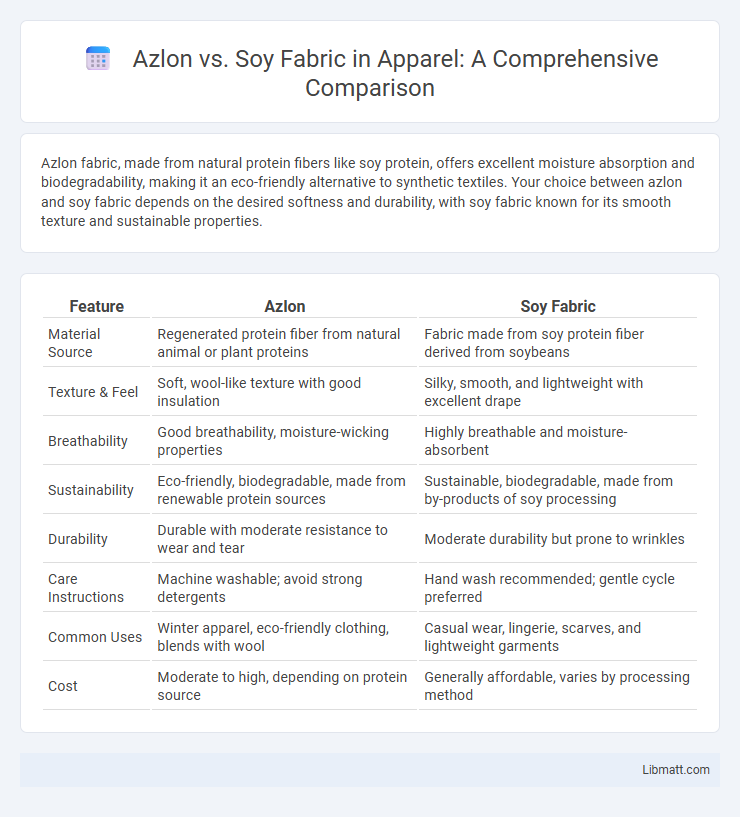Azlon fabric, made from natural protein fibers like soy protein, offers excellent moisture absorption and biodegradability, making it an eco-friendly alternative to synthetic textiles. Your choice between azlon and soy fabric depends on the desired softness and durability, with soy fabric known for its smooth texture and sustainable properties.
Table of Comparison
| Feature | Azlon | Soy Fabric |
|---|---|---|
| Material Source | Regenerated protein fiber from natural animal or plant proteins | Fabric made from soy protein fiber derived from soybeans |
| Texture & Feel | Soft, wool-like texture with good insulation | Silky, smooth, and lightweight with excellent drape |
| Breathability | Good breathability, moisture-wicking properties | Highly breathable and moisture-absorbent |
| Sustainability | Eco-friendly, biodegradable, made from renewable protein sources | Sustainable, biodegradable, made from by-products of soy processing |
| Durability | Durable with moderate resistance to wear and tear | Moderate durability but prone to wrinkles |
| Care Instructions | Machine washable; avoid strong detergents | Hand wash recommended; gentle cycle preferred |
| Common Uses | Winter apparel, eco-friendly clothing, blends with wool | Casual wear, lingerie, scarves, and lightweight garments |
| Cost | Moderate to high, depending on protein source | Generally affordable, varies by processing method |
Introduction to Azlon and Soy Fabric
Azlon is a high-performance fiber made from regenerated protein sources, primarily soy protein, designed to offer eco-friendly textile alternatives. Soy fabric, derived from soy protein extracted from soybean residue, provides a soft, breathable, and biodegradable material ideal for sustainable clothing. Understanding the differences highlights your options for environmentally conscious and innovative textile choices.
Composition and Source Materials
Azlon fabric is a regenerated fiber primarily made from natural protein sources such as soy protein, casein from milk, or peanut protein, offering a sustainable alternative derived from agricultural by-products. Soy fabric, a subset of Azlon, is specifically produced from soy protein isolate extracted from soybeans, emphasizing plant-based origin and biodegradability. Both materials highlight eco-friendly compositions, but Azlon's broader range of protein sources distinguishes it from soy fabric's exclusive reliance on soybeans.
Manufacturing Processes
Azlon fabric is produced from regenerated proteins derived primarily from animal sources such as soy, casein, or milk, using a process that involves extracting proteins, dissolving them in solvents, and then regenerating fibers through spinning techniques. Soy fabric, a subtype of Azlon, specifically utilizes soy protein extracted from soybean waste, which is chemically processed and spun into fibers with a focus on sustainability and biodegradability. Your choice between Azlon and soy fabric depends on the manufacturing nuances, including the source of protein and chemical treatments applied during fiber regeneration.
Environmental Impact and Sustainability
Azlon fabric, derived from natural protein fibers like soy, offers a biodegradable alternative, whereas soy-based fabric specifically leverages renewable soy protein, reducing reliance on synthetic materials and minimizing environmental footprint. Both materials support sustainable practices by utilizing agricultural byproducts, lowering water consumption, and emitting fewer greenhouse gases compared to conventional fabrics. Choosing Azlon or soy fabric for Your textiles promotes eco-friendly production and contributes to a circular economy.
Physical Properties and Performance
Azlon fabric, derived from natural protein fibers like soy protein, offers excellent moisture absorption and a soft, smooth texture that enhances comfort. Soy fabric provides good breathability and elasticity, making it suitable for activewear and casual clothing, while Azlon tends to have superior durability and wrinkle resistance due to its protein-based composition. Your choice between Azlon and soy fabric should consider the specific physical properties, such as tensile strength and moisture management, to meet performance needs in various applications.
Comfort and Wearability
Azlon fabric offers superior moisture-wicking properties and breathability compared to soy fabric, making it ideal for active wear and warm climates. Soy fabric provides a softer, silk-like feel with excellent stretchability, enhancing comfort for casual wear and sensitive skin. Both fabrics are biodegradable and sustainable, but Azlon's durability gives it an edge in long-term wearability.
Durability and Care Requirements
Azlon fabric, made from regenerated protein fibers like soy, offers superior durability due to its strong fiber structure, making it resistant to wear and tear over time. Soy fabric, while soft and biodegradable, tends to be less durable and may require gentler handling and lower washing temperatures to maintain its integrity. Proper care for Azlon includes machine washing with mild detergents, whereas soy fabric demands delicate washing cycles and air drying to prevent damage.
Cost and Market Availability
Azlon fabric, derived primarily from natural protein sources such as soy or milk, tends to be more expensive than conventional soy fabric due to its specialized production processes and limited scalability. Soy fabric, often produced from soy protein fibers, is more widely available in the market and benefits from lower manufacturing costs, making it a more economical choice for mass-produced textile products. The niche market of Azlon results in higher price points and fewer suppliers compared to the broader and more established soy fabric industry.
Popular Uses and Applications
Azlon fibers, derived from regenerated protein sources like soy, are widely used in fashion and activewear due to their softness, durability, and moisture-wicking properties. Soy fabric, a subset of Azlon, is popular in eco-friendly clothing, upholstery, and home textiles for its biodegradability and smooth texture. Both materials are favored in sustainable product lines, offering alternatives to conventional synthetic and natural fibers in apparel and interior design.
Azlon vs Soy Fabric: Which Is Better?
Azlon, a regenerated protein fiber made from natural sources like milk and soy, offers superior moisture retention, strength, and biodegradability compared to soy fabric, which is typically crafted from soy protein fibers. Your choice depends on durability and environmental impact, with Azlon providing enhanced performance for clothing and upholstery due to its resilience and sustainability. Both fabrics support eco-friendly fashion, but Azlon's advanced processing makes it better suited for long-lasting, breathable textiles.
Azlon vs soy fabric Infographic

 libmatt.com
libmatt.com